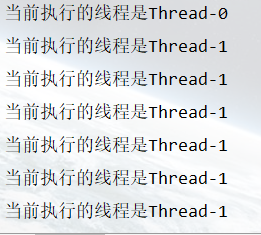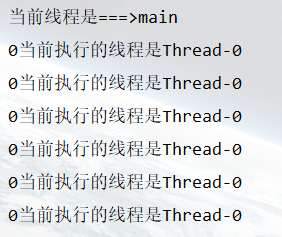Java的多线程1:线程的使用
概述

public enum State { /** * Thread state for a thread which has not yet started. */ NEW, /** * Thread state for a runnable thread. A thread in the runnable * state is executing in the Java virtual machine but it may * be waiting for other resources from the operating system * such as processor. */ RUNNABLE, /** * Thread state for a thread blocked waiting for a monitor lock. * A thread in the blocked state is waiting for a monitor lock * to enter a synchronized block/method or * reenter a synchronized block/method after calling * {@link Object#wait() Object.wait}. */ BLOCKED, /** * Thread state for a waiting thread. * A thread is in the waiting state due to calling one of the * following methods: * <ul> * <li>{@link Object#wait() Object.wait} with no timeout</li> * <li>{@link #join() Thread.join} with no timeout</li> * <li>{@link LockSupport#park() LockSupport.park}</li> * </ul> * * <p>A thread in the waiting state is waiting for another thread to * perform a particular action. * * For example, a thread that has called <tt>Object.wait()</tt> * on an object is waiting for another thread to call * <tt>Object.notify()</tt> or <tt>Object.notifyAll()</tt> on * that object. A thread that has called <tt>Thread.join()</tt> * is waiting for a specified thread to terminate. */ WAITING, /** * Thread state for a waiting thread with a specified waiting time. * A thread is in the timed waiting state due to calling one of * the following methods with a specified positive waiting time: * <ul> * <li>{@link #sleep Thread.sleep}</li> * <li>{@link Object#wait(long) Object.wait} with timeout</li> * <li>{@link #join(long) Thread.join} with timeout</li> * <li>{@link LockSupport#parkNanos LockSupport.parkNanos}</li> * <li>{@link LockSupport#parkUntil LockSupport.parkUntil}</li> * </ul> */ TIMED_WAITING, /** * Thread state for a terminated thread. * The thread has completed execution. */ TERMINATED; }
新建状态
线程对象创建后,就进入新建状态 Thread thread = new Thread
就绪状态
调用start()方法,线程进入就绪状态,但并不意味着线程就立即执行,只是说明此线程已经做好准备,随时等待CPU调度执行。
阻塞状态
多个线程同时竞争一个独占锁,其他未抢到锁的线程,就进入阻塞状态被放置到锁池中,直到获取到锁,进入就绪状态
等待状态
该线程需要等待其他线程做出一些特定动作,通知或者是中断,等待其被其他线程唤醒,像CountDownLatch就可以等待一个或者几个线程结束。
超时等待状态
和等待状态不同的是,它可以在指定的时间自行的返回,sheep(long)函数就会让线程进入超时等待状态,时间到了才会转入就绪状态。
运行状态(Running)
CPU调度处于就绪状态的线程时,这个线程才真正执行,进入运行状态。
终止状态
线程正常执行完毕后或提前强制性终止或出现异常,线程就要销毁,释放资源。
Java创建线程的两种方式
继承Thread类
public class ThreadDemo1 extends Thread { @Override public void run(){ for (int i = 0; i < 10; i++) { System.out.println("当前执行的线程是" + Thread.currentThread().getName()); } } public static void main(String[] args) { ThreadDemo1 threadDemo1 = new ThreadDemo1(); ThreadDemo1 threadDemo2 = new ThreadDemo1(); threadDemo1.start(); threadDemo2.start(); } }
执行结果是不确定的

实现Runnable
public class ThreadDemo2 implements Runnable { @Override public void run() { for (int i = 0; i < 10; i++) { for (int j = 0;j < 1000; ++j){ System.out.println(i + "当前执行的线程是" + Thread.currentThread().getName()); } } } public static void main(String[] args) { ThreadDemo2 threadDemo1 = new ThreadDemo2(); ThreadDemo2 threadDemo2 = new ThreadDemo2(); Thread thread1 = new Thread(threadDemo1); Thread thread2 = new Thread(threadDemo2); thread1.start(); thread2.start(); System.out.println("当前线程是===>" + Thread.currentThread().getName()); } }
主线程的名字为main,非主线程的名字是由虚拟机来指定的,同时,我们也可以为线程指定具体的名称。

我们保证每个线程都能正常启动,并不意味着它会按顺序的执行,因为调度程序是无法保证它的执行次序的,同时,run()函数结束时,意味着该线程的任务完成了。
注意:调用线程要调用start,如果调用run,那仅仅是简单的对象调用。
线程的方法调用
获取线程基本信息
public class ThreadDemo6 { public static void main(String[] args) { Thread thread = new Thread(){ @Override public void run(){ /*获取线程唯一id标识*/ long id = this.getId(); System.out.println("thread的ID==>" + id); /*获取线程名字*/ String name = this.getName(); System.out.println("thread的名字==>" + name); /*获取线程的优先级 默认5 1-10*/ int priority = this.getPriority(); System.out.println("thread的优先等级==>" + priority); /*查看当前线程是否为守护线程*/ boolean isDaemon = this.isDaemon(); System.out.println("thread是否为守护线程==>" + isDaemon); /*查看线程是否被中断*/ boolean isInterrupted = this.isInterrupted(); System.out.println("thread是否被中断==>" + isInterrupted); } }; thread.start(); } }
执行结果
thread的ID==>11 thread的名字==>Thread-0 thread的优先等级==>5 thread是否为守护线程==>false thread是否被中断==>false
Thread.yield()
public class ThreadDemo1 implements Runnable { protected int countDown = 10; private static int taskCount = 0; private final int id = taskCount++; public ThreadDemo1(){} public ThreadDemo1(int countDown){ this.countDown = countDown; } public String status(){ return "#" + id + "(" + (countDown > 0 ? countDown : "stop!") + ")"; } @Override public void run() { while (countDown-- > 0){ System.out.println(status() + " "); Thread.yield(); } } public static void main(String[] args) { for (int i = 0; i < 3; i++){ new Thread(new ThreadDemo1()).start(); } } }
#0(9)#0(8)#0(7)#0(6)#0(5)#0(4)#0(3)#0(2)#0(1)#0(stop!)
#1(9)#1(8)#1(7)#1(6)#1(5)#1(4)#1(3)#1(2)#1(1)#1(stop!)
#2(9)#2(8)#2(7)#2(6)#2(5)#2(4)#2(3)#2(2)#2(1)#2(stop!)
这个是一个倒计时的任务,对Thread.yield()调用是对线程调度器的一种建议,它在声明“我已经执行完生命周期中最重要的部分了,此刻正是切换给其他任务执行一段时间的大好时机”,说白就是自己按暂停键,让出自己CPU的使用权限,转为就绪状态,至于下一次什么时候能获得CPU调度就不一定了,有时很快,有时得等上一会。
Thread.sleep
public class ThreadDemo1 implements Runnable { protected int countDown = 10; private static int taskCount = 0; private final int id = taskCount++; public ThreadDemo1(){} public ThreadDemo1(int countDown){ this.countDown = countDown; } public String status(){ return "#" + id + "(" + (countDown > 0 ? countDown : "stop!") + ")"; } @Override public void run() { try { while (countDown-- > 0){ System.out.println(status()); Thread.sleep(1000); } } catch (InterruptedException e) { e.printStackTrace(); } } public static void main(String[] args) { for (int i = 0; i < 3; i++){ new Thread(new ThreadDemo1()).start(); } } }

Thread.sleep(long)将使“正在执行的任务“中止执行给定的时间(暂停执行)并且让出CPU使用权,这个语句相当于说在接下来的1秒内,你都不要叫我,我想睡一会,1秒睡眠时间过后,它自动转为就绪状态,但CPU不一定马上执行这个睡醒的线程,这要取决于是否抢到CPU时间片段。值得注意的是如果sleep和yield上下文被加锁了,它们依然使用锁,不会去释放。而sleep与yield最大的不同是,yield不会让线程进入等待状态,只是把线程转为就绪状态,并把CPU执行机会让步给优先级相同或者更高的线程,而sleep能控制具体交出CPU的使用时间。
Thread.currentThread()
public class ThreadDemo2 extends Thread { static { System.out.println("静态块执行的线程===>" + Thread.currentThread().getName()); } { System.out.println("非静态块执行的线程是====>" + Thread.currentThread().getName()); System.out.println("this.getName()1=====>" + this.getName()); } public ThreadDemo2(){ System.out.println("构造方法内执行的线程====>" + Thread.currentThread().getName()); System.out.println("this.getName()2=====>" + this.getName()); } @Override public void run() { System.out.println("当前执行的线程为====>" + Thread.currentThread().getName()); System.out.println("this.getName()3=====>" + this.getName()); } public static void main(String[] args) { ThreadDemo2 threadDemo2 = new ThreadDemo2(); threadDemo2.start(); } }
执行结果
静态块执行的线程===>main 非静态块执行的线程是====>main this.getName()1=====>Thread-0 构造方法内执行的线程====>main this.getName()2=====>Thread-0 当前执行的线程为====>Thread-0 this.getName()3=====>Thread-0
currentThread返回的是当前正在执行线程对象的引用,它与this.getName()有明显的不同,执行静态块,非静态块,构造方法的线程是main,而非ThreadDemo2,在执行run()方法的才是实例化的线程threadDemo2。所以在当前执行的Thread未必就是Thread本身。
isAlive()
public class ThreadDemo3 extends Thread { @Override public void run(){ System.out.println("执行执行====" + this.isAlive()); } public static void main(String[] args) { ThreadDemo3 threadDemo3 = new ThreadDemo3(); System.out.println("begin===>" + threadDemo3.isAlive()); threadDemo3.start(); System.out.println("end==>" + threadDemo3.isAlive()); } }
begin===>false end==>true 执行执行====true
isAlive()检测线程是否处于活动状态,活动状态返回true
setPriority()
优先级设定,优先级高的线程越容易获取CPU使用权,
public class ThreadDemo4 { public static void main(String[] args) { for (int i = 0; i < 5; ++i){ Thread1 thread1 = new Thread1(); thread1.setPriority(6); Thread2 thread2 = new Thread2(); thread2.setPriority(4); thread2.start(); thread1.start(); } } } class Thread1 extends Thread{ @Override public void run(){ for (int i = 0; i < 100000; ++i){ System.out.println("+++++++++++++"); } } } class Thread2 extends Thread{ @Override public void run(){ for (int i = 0; i < 100000; ++i){ System.out.println("--------------"); } } }
执行结果
+++++++++++++ +++++++++++++ +++++++++++++ +++++++++++++ +++++++++++++ +++++++++++++ +++++++++++++ +++++++++++++
...
CPU会将资源尽量让给优先级高的线程
setDaemon()
守护线程,也有人叫后天线程,我们创建出来的线程默认都是前台线程,在使用上来说,守护线程和前台线程是没啥区别,区别在于进程结束,当一个进程中的所有前台线程都结束时,无论这个进程中的守护线程是否还在运行都要强制将他们结束。也就是说前台线程都结束了,守护线程也会自动销毁,它是为其他线程提供便利而存在的。
/*rose与jack*/ public class ThreadDemo5 { public static void main(String[] args) { Rose rose = new Rose(); Jack jack = new Jack(); /*设置为守护线程必须在线程未启动之前*/ jack.setDaemon(true); rose.start(); jack.start(); } } class Rose extends Thread{ @Override public void run(){ for (int i = 0; i < 5; ++i){ System.out.println("rose: let me go!"); try { Thread.sleep(1000); } catch (InterruptedException e) { e.printStackTrace(); } } System.out.println("成功跳水"); } } class Jack extends Thread{ @Override public void run(){ while (true){ System.out.println("jack:you jump! i jump!"); try { Thread.sleep(1000); } catch (InterruptedException e) { e.printStackTrace(); } } } }
执行结果
rose: let me go! jack:you jump! i jump! rose: let me go! jack:you jump! i jump! rose: let me go! jack:you jump! i jump! rose: let me go! jack:you jump! i jump! rose: let me go! jack:you jump! i jump! 成功跳水
jack守护着rose,jack是守护线程,当rose跳水后,jack认为自己也没有活着的必要了,也自己销毁了,但注意一点是这当中还有一个第三者main,需要main也运行完jack线程才会销毁。
join()
这个方法可以协调多个线程同步运行,多线程运行本身是设计异步运行的,但在程序运行业务中,有可能线程A的计算需要线程B的返回结果,这就需要他们执行各自任务时要有先后,join就需要协调这些线程同步运行。
public class ThreadDemo6 { private static boolean isFinish = false; public static void main(String[] args) { Thread download = new Thread(){ @Override public void run(){ System.out.println("下载图片中....."); for (int i = 1; i <= 100; ++i){ System.out.println("下载进度" + i + "%"); try { Thread.sleep(1000); } catch (InterruptedException e) { e.printStackTrace(); } } System.out.println("图片下载完毕"); isFinish = true; } }; Thread show = new Thread(){ @Override public void run(){ System.out.println("开始显示图片..."); try { download.join(); } catch (InterruptedException e) { e.printStackTrace(); } if (!isFinish){ throw new RuntimeException("图片下载出错"); } System.out.println("图片正常展示。。。"); } }; download.start(); show.start(); } }
执行结果
下载图片中..... 开始显示图片... 下载进度1% 下载进度2% ... 下载进度100% 图片下载完毕 图片正常展示。。。
show调用join会使show无限阻塞,直到down线程销毁为止,它和sleep最大的区别是join会释放锁,而sleep不会。
涉及到jmm内存模型,线程安全等,后面在介绍


 浙公网安备 33010602011771号
浙公网安备 33010602011771号